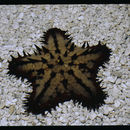en
names in breadcrumbs


In Panama this species has been collected from Taboguilla Island (depth 5 m), Taboga Island (USNM E 33332), Pedro Gonzales Island, Perlas Archipelago (USNM E 37207; Centroid Latitude: 8.3783, Centroid Longitude: -79.1033), Balboa Island, Panama Bay (USNM 39002, depth 6 m), Bona Island Panama Bay (USNM E 37328, depth 9 m), Paitilla Point, Panama Bay (USNM E 26727) and Perico Island, Panama Bay (USNM E 32007), Gulf of Panama, eastern Pacific.
Panama, eastern Pacif
Döderlein, L. (1936). Die Asteriden der Siboga-Exped. III. Die unterfamile Oreasterinae. Siboga-Expedition, 46(2): 295-369, pls. 21-32.
LSID urn:lsid:marinespecies.org:taxname:254919Goniodiscus armata Lutken, 1859
Goniodiscus conifer Möbius, 1859 (A synonym accoridng to Sladen (1889).)
Goniodiscus michelini Perrier, 1869
Goniodiscus stella Verill, 1870
Nidorellia michelini (Perrier, 1869) (A synonym according to Doderlein (1936))
Oreaster armatus Müller & Troschel, 1842
Pentaceros armatus Gray, 1840
Nidorellia armata, also known as the chocolate chip star (leading to easy confusion with Protoreaster nodosus), is a species of starfish from warmer parts of the East Pacific, where it ranges from the Gulf of California to northwest Peru, including the Galápagos.[2] It is the only species in the genus Nidorellia. N. armata can be found in tropical waters clinging on corals and rocky reefs; and are sometimes kept as pets in home marine aquariums.
Nidorellia armata, also known as the chocolate chip star (leading to easy confusion with Protoreaster nodosus), is a species of starfish from warmer parts of the East Pacific, where it ranges from the Gulf of California to northwest Peru, including the Galápagos. It is the only species in the genus Nidorellia. N. armata can be found in tropical waters clinging on corals and rocky reefs; and are sometimes kept as pets in home marine aquariums.